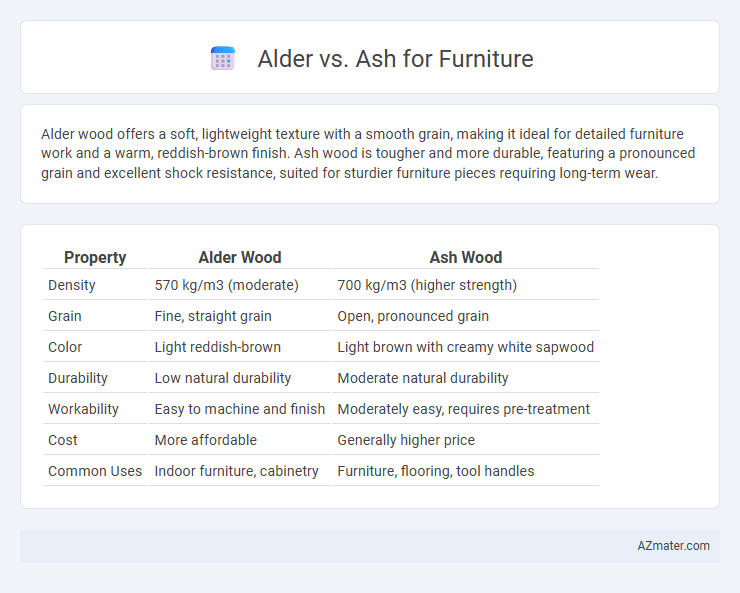Alder wood offers a soft, lightweight texture with a smooth grain, making it ideal for detailed furniture work and a warm, reddish-brown finish. Ash wood is tougher and more durable, featuring a pronounced grain and excellent shock resistance, suited for sturdier furniture pieces requiring long-term wear.
Table of Comparison
| Property | Alder Wood | Ash Wood |
|---|---|---|
| Density | 570 kg/m3 (moderate) | 700 kg/m3 (higher strength) |
| Grain | Fine, straight grain | Open, pronounced grain |
| Color | Light reddish-brown | Light brown with creamy white sapwood |
| Durability | Low natural durability | Moderate natural durability |
| Workability | Easy to machine and finish | Moderately easy, requires pre-treatment |
| Cost | More affordable | Generally higher price |
| Common Uses | Indoor furniture, cabinetry | Furniture, flooring, tool handles |
Introduction to Alder and Ash Wood
Alder wood is a soft hardwood known for its smooth texture and light brown color with subtle grain patterns, making it ideal for furniture that requires ease of staining and finishing. Ash wood, a harder hardwood, features a more pronounced grain pattern with a pale beige to light brown hue, offering greater strength and durability for furniture pieces that demand resilience. Both woods are valued in furniture-making for their unique aesthetic and functional properties, with alder providing warmth and workability, while ash delivers robust support and visual character.
Wood Grain and Aesthetic Comparison
Alder wood features a fine, straight grain with a uniform texture that enhances its warm, rich reddish-brown hues, making it ideal for rustic and traditional furniture styles. Ash, on the other hand, exhibits a pronounced, open grain pattern with lighter, creamy tones that highlight its natural strength and lend a contemporary, clean aesthetic to furniture pieces. The distinct grain visibility in ash offers a bold statement, while alder's subtle grain provides a smoother and more versatile visual appeal.
Hardness and Durability: Alder vs Ash
Ash wood is significantly harder and more durable than alder, making it an ideal choice for furniture that must withstand heavy use and wear over time. Alder is a softer wood with a Janka hardness rating around 590, which makes it easier to dent and scratch, whereas ash scores approximately 1,320 on the Janka scale, indicating strong resistance to impact. For long-lasting furniture pieces that maintain their structural integrity, ash provides superior hardness and durability compared to the more delicate alder.
Workability and Ease of Crafting
Alder wood is known for its excellent workability due to its soft texture and fine, even grain, making it ideal for intricate carving and shaping in furniture crafting. Ash offers superior strength and durability with a coarser grain, yet it remains easy to work with hand and power tools, especially for heavier, structural pieces. Both woods sand smoothly and hold finishes well, but alder's softer nature reduces tool wear and effort, making it a preferred choice for artisans prioritizing ease of crafting.
Staining and Finishing Properties
Alder wood offers a smooth, consistent grain that readily absorbs stain, resulting in even and rich finishes ideal for contemporary furniture styles. Ash features a pronounced grain pattern that can highlight natural textures when stained, but it tends to absorb finishes unevenly without proper surface preparation. Both woods respond well to various finishing techniques, yet alder's uniformity provides more predictable staining outcomes compared to ash's distinctive grain complexity.
Cost and Availability Factors
Alder wood generally costs less than ash, making it a budget-friendly option for furniture projects. Alder is widely available in North America, which contributes to its affordability and ease of sourcing. Ash, while slightly more expensive, is known for its durability and is also commonly available but can vary in price depending on regional demand.
Environmental Impact and Sustainability
Alder furniture is favored for sustainability due to its fast growth rate and frequent replanting in managed forests, resulting in a smaller carbon footprint compared to slower-growing hardwoods like ash. Ash trees, while durable and strong, take longer to mature, leading to increased environmental impact through extended logging cycles and reduced carbon sequestration. Choosing alder supports reduced deforestation and promotes eco-friendly forestry practices, making it a more environmentally responsible option for furniture production.
Ideal Applications for Alder Furniture
Alder furniture is ideal for rustic and casual interior designs due to its soft texture and warm, reddish-brown hues that age beautifully with a smooth finish. Its lightweight nature makes it perfect for crafting detailed cabinetry, doors, and decorative furniture pieces that require easy manipulation and intricate carving. Compared to Ash, Alder is preferred for indoor applications where a natural, cozy aesthetic is desired without the need for high resistance to wear and tear.
Best Uses for Ash in Furniture Design
Ash wood is prized in furniture design for its exceptional strength, flexibility, and attractive grain patterns, making it ideal for pieces that require durability and aesthetic appeal, such as chairs, tables, and flooring. Its natural shock resistance and workability allow designers to create both intricate and functional items that stand up to daily use. Ash's light color and smooth finish also enhance modern and Scandinavian furniture styles, providing a bright, clean look that complements various interiors.
Choosing the Right Wood: Alder or Ash?
Alder wood is prized for its warm tones and smooth grain, making it ideal for rustic or traditional furniture designs, while ash offers superior hardness and resilience with a more pronounced grain, suited to modern or high-traffic pieces. Alder's affordability and ease of staining provide versatility for custom finishes, whereas ash's strength and durability ensure long-lasting structural integrity in heavy-use furniture. Selecting between alder and ash hinges on balancing aesthetic preferences with functional needs, such as desired durability and style compatibility.

Infographic: Alder vs Ash for Furniture
 azmater.com
azmater.com